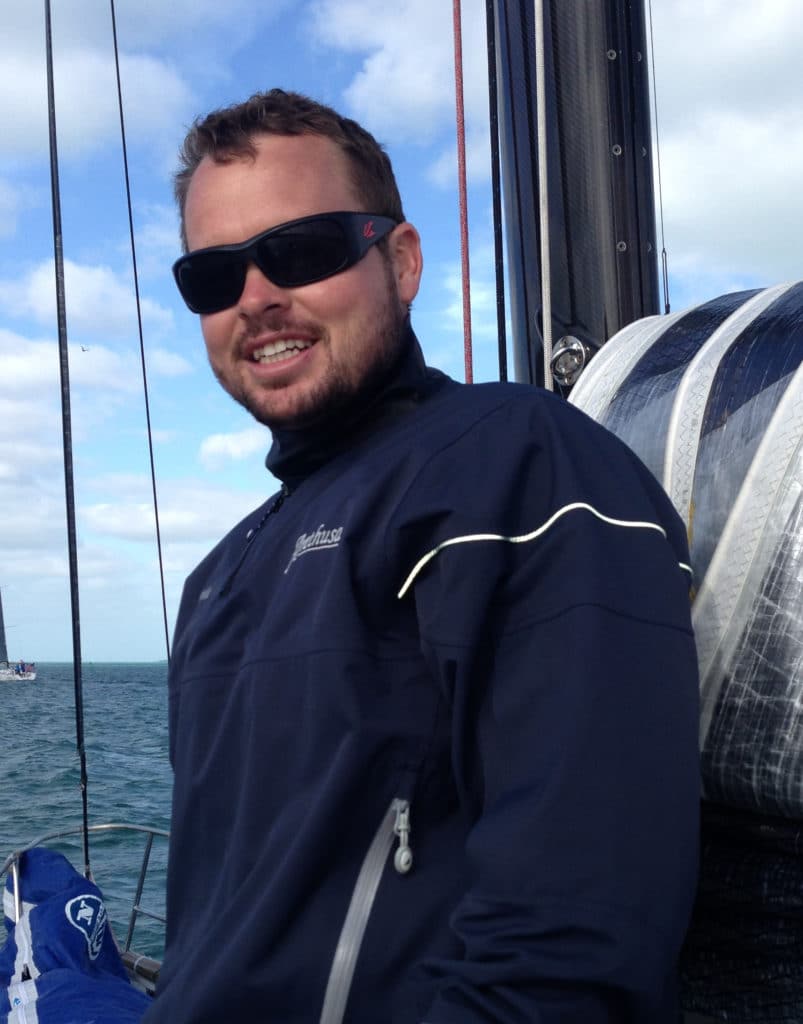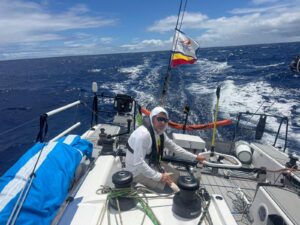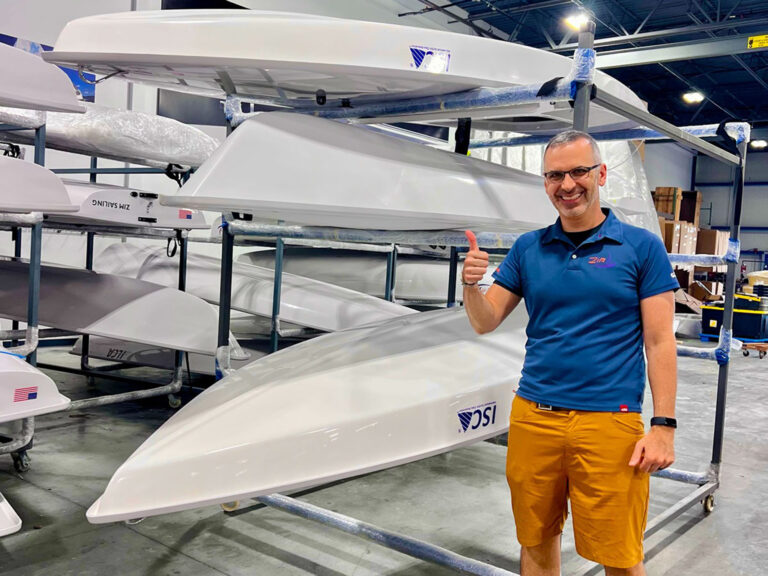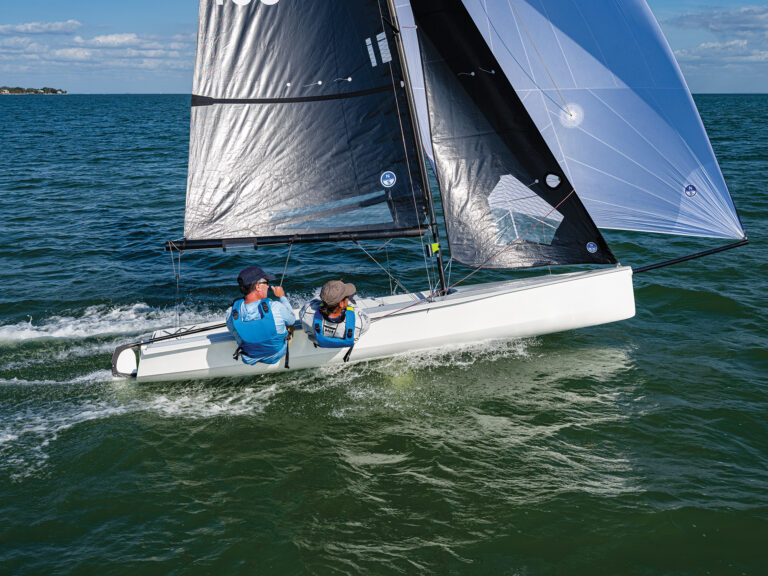
Tyson Lamond
Seven Tips From Tyson
A decade ago, 18-year-old Tyson Lamond left his hometown of Adelaide, Australia, in pursuit of his dream of becoming a professional sailor. In his pocket, he had two things: some cash he’d saved up working a part-time job, and a commitment from an English owner for a week of Farr 40 sailing. He turned that regatta into a full season of sailing in Europe and then turned that season into a career. At 28, he’s just finished a six-year stint with Emirates Team New Zealand, where he was a boat captain for a number of the team’s race boats over that span, including their AC45, Extreme 40 and TP52. He’s also a highly regarded bowman. In simple terms, he has achieved his dream.
Spend a few days on the boat with Tyson—as I did during both the Fort Lauderdale to Key West Race and Quantum Key West Race Week—and it’s easy to see why he’s been able to make a name for himself in the world of professional sailing at a relatively young age. He’s a very competent bowman, extremely knowledgeable about all aspects of the sport, unflappable when things go awry, and very easy to get along with. He is, as he is fond of saying about some of his mates in the business, “a good yachtie.”
Luck, he’ll be the first to admit, has played a role. The track from talented youth sailor to successful professional is vague at best. Few sailors can successfully navigate it without some help. But luck will only get you so far. So I asked Lamond for some advice he could give to young sailors hoping to pursue a similar career path.
1- Learn a trade. With a few exceptions, virtually every member of an America’s Cup or Volvo Ocean Race sailing team will have an alternate skill that will help push the team forward. The big five are: rigging, boatbuilding, sailmaking, electronics, and hydraulics. While technical training won’t hurt, each of these skills can also be learned, to some extent, on the job. “It’s all about being there and being willing to put the time in,” he says. “Get involved, get dirty.”
2-Treat every job with respect: “It doesn’t matter what you’re doing, take whatever job you can get to get you on the next step. If your job is going in the RIB and passing on the water bottles to the sailing team, pass the water bottles on. It gets you involved with the next group of people, the next team, and it gets you exposure and experience. You’re going to be in situations with teams where you’re not sailing. You can’t put your head down; you’ve got to do whatever is the best thing for the team. You can’t be all about you and what you want to do that day, you have to think about the bigger picture.”
3-Create demand: “If you end up busy enough and you’ve done enough work and people really want you to sail with them, they’re going to pay for you. For me, I was working on boats and doing all these extra things and eventually I couldn’t afford to pass up non-sailing jobs to go sailing for free. I would be saying, “Well, if you can’t pay me to sail, I have to go work on this other boat.”
4-“Never think too much or too little of a program. It doesn’t matter what you’re doing, or racing on, look at everything as a stepping stone and never be short-sighted.”
5-Be eager: “When I sailed with the Artemis program, I was really young and I had to work to show them I was the keenest. I would go down really early in the morning and do all my things, and do all the extra things I could find to gain their respect, because it just doesn’t happen.”
6-Check and re-check: “Doublecheck everything you do because it costs a lot of money when you make mistakes on these boats.” While no one likes to be the cause of a short delay during a race, it’s always important to remember that a short delay to ensure everything will go properly in a maneuver will usually only cost your team a few seconds, but a mistake in the maneuver could cost minutes, if not more. “The first mistake always leads to the next. So if you make a mistake, take it easy and fix it. Don’t rush into the next mistake.”
7-Be confident: “If you don’t have confidence in yourself then no one else around you will have confidence in you.”
(previous page for older posts)
**
**
Got it Done
Twice I’ve watched my chances of winning a class at Quantum Key West fade in a shifty northeasterly wind. The first time was in 2008, the second a year ago. In both cases, we played the middle on the second beat in a crucial race and watched boats on both sides work past us and knock us from contention. Each experience left me wondering what I needed to do to take home a victory in North America’s premiere big-boat regatta.
The second race on the penultimate day of 2014 Quantum Key West was, as they say, déjà vu all over again. A fourth in the first race of the day, the seventh of an expected 10-race series for IRC 3, had narrowed our lead over second to three points. Halfway through Race 8, it appeared that the team with which I was sailing, Phil and Wendy Lotz’ Swan 42 Arethusa, would be fortunate to finish the day in the first place in the overall standings. The fast boats were well ahead; taking advantage of the clean air their speed afforded them. A handful of other boats, all close to us in rating, had invested heavily in the right and appeared to be making significant gains. Meanwhile we were unhappily working the center left, pinned by a competitor we knew from experience wouldn’t let us cross without a fight.
In 2014, as it has for the past few years, Division 1 raced just to the west of the main ship channel. The northeasterly breeze blows right over the island, and despite quite a bit of fetch between the island and the windward mark, it’s always a particularly challenging direction. While I don’t have the photographic race-by-race recall that seems to bless all great tacticians, I do remember those regatta-losing races with particular clarity. As we sailed that second beat on Thursday, I could smell disappointment like a week-old banana peel left under the seat. “I’ve seen this movie before,” I grunted underneath my breath. Then I refocused, put my head down and hiked a little bit harder.
Key West may not be what it was as its peak, when there were four circles, 300 boats and the enormous tent a block back from the waterfront. But winning Key West Race Week is still one of the most universally recognized badges of honor in the amateur sailing world. The continued presence of international teams in numerous classes speaks to that.
And I’m not sure it’s much easier to win—at least from the perspective of an amateur journeyman trimmer like myself. The classes may be smaller, but they’re more distilled. And whatever is lost in the shrinkage is more than compensated for by the increased difficulty in finding a ride. Getting that mid-year email, “Any interest in sailing Key West in January?” is still among the best early Christmas presents for any competitive sailor.
When I realized that the Swan 42 class wouldn’t have enough boats for a one-design start at Key West, I was disappointed. I love one-design big-boat sailing. In addition I wasn’t sure about our chances of beating some of the custom IRC weapons we were sure to come up against.
In the end, though, the work Phil and Wendy Lotz put into improving Arethusa’s IRC performance paid off. The modifications resulted in a positive rating change of approximately one minute per hour compared to the standard Swan 42 rating. And, at the risk of being immodest, we sailed well, beating all three other Swan 42s boat-for-boat in seven of 10 races.
Despite my mid-beat misgivings, Thursday’s second race wound up being one of the seven. Tactician Jeff Madrigali picked his way through a minefield of right-hand pressure to round the second windward mark in position to make a move down the run, which is where Arethusa’s old-school modifications—spinnaker pole and symmetric spinnaker—really pay off. The team remained focused and crossed the line fifth. On corrected time, we finished second. We lost another point to the boat in second in the overall standings, but then picked up five in the third race of the day to put ourselves in a very comfortable position for Friday’s final, windy race.
I felt a little bewildered up on the stage on Friday night with the rest of the team. But perhaps that shouldn’t be too surprising. After seven unsuccessful tries over 14 years, I’ve finally realized the value of focusing on the process instead of the outcome.
**
**
Salvage Operation
This year is the seventh time I’ve competed at Quantum Key West Race Week. Five times I sailed in strict one-design classes and the other time was as part of a five-boat TP52 sub-class that raced with a few other boats in a PHRF fleet.
Practically speaking, this year, onboard Phil Lotz’s modified Swan 42, is the first time I’ve really raced against the clock at Key West. Like many sailors, I prefer the simplicity of one-design sailing. That said, I feel quite fortunate to be in Key West at all and also to be a part of what appears to be a very competitive and very interesting handicap class.
There are 10 boats in IRC 3, ranging from 40 to 46 feet long and with an IRC rating spread of 1.156 to 1.273. That’s approximately 6 minutes, per hour, between the fastest and slowest boats in the group. Between the slowest 7 boats, there’s just 2 minutes per hour.
Arethusa, the boat on which I’m sailing, is a Swan 42 that can be taken out of class trim for IRC racing. This week, we’re sailing with a spinnaker pole, a mix of asymmetric and symmetric downwind sails and a few other modifications. All told, these changes drop our rating from the class standard of 1.175 to 1.156, making us the slowest-rated boat in our class.
Past experience in IRC regattas against other Swan 42s has shown us that the optimization is a good move. Like most things in life, however, it doesn’t come for free. Our weak point is in very light breeze. With today’s forecast topping out at 6 knots, we headed out for sailing hoping the forecast was drastically wrong or that maybe we wouldn’t get in both scheduled races. Neither came true.
We struggled in Race 1. After a strong start we slowly bled time around the track and finished well adrift of the leading boats, including two of the three stock Swan 42s sailing in the class. After finishing we cursed our inability to get the boat rumbling in the light and variable breeze and prayed that PRO Ken Legler would take the hint from radio chatter and send us in. But Legler stuck to his guns and sent all five fleets on Circle 1 off for a second race. We gritted our teeth and steeled ourselves for another tough race.
There’s a lot of danger in putting too much stock into your own limitations. We might be an underdog in light air, but we can still compete. We nailed the start of Race 2, hit a few shifts on the first three legs and, on the final run to the finish, managed to hold our ground against boats that should be faster in a straight line. The end result was a third place on elapsed time and a win on corrected time.
With a 7-1 for the day, we’re in a tie for third, four points off the lead. Another bad race wouldn’t have been fatal, not with a strong forecast for the remainder of the week, but it would’ve put us in a big hole. Instead we emerged from a potentially tough day relatively unscathed and with a potent reminder that no matter what the form card says, each team still has to sail their boat around the track.
(click below for previous posts)
Worries? No Worries.
One of the memorable topics of conversation onboard the Swan 42 Arethusa during the 2014 Fort Lauderdale to Key West Race was the lack of an antithetical expression to the Antipodean classic, “No worries.”
This came up primarily due to the presence of ex-Emirates Team New Zealand bowman Tyson Lamond, who’s actually Australian, who’d come onboard to ensure we correctly got the sails up and down during the race.
When he didn’t have a good response, we decided it was our duty to come up with one. And given that we were somewhat sleep-addled from the 30-plus sail changes we did over the course of the 18-hour race, the best we could come up with was, “Worries, mate, worries.”
There’s a lot to be said for the delivery. But, it still wasn’t much of an effort. Nonetheless the conversation provided many laughs as we bashed upwind in 25 to 30 knots over the final third of the 18-hour race.
Little did we know, two days later, we’d be breaking out our new expression with an absence of humor. We weren’t an hour into our first practice day for Quantum Key West Race Week when, with Tyson up the rig to adjust the tension on the D2 shrouds, we jibed over in 20-plus knots and put a six-foot rip in our mainsail.
“Worries, mate, worries,” was all that went through my mind as I stared up at the gaping hole in the one irreplaceable sail in our inventory. Was this the end of our regatta?
We took the jib down and then did the same, with as much tenderness as was possible, with the main. Then we turned on the motor and headed for the dock.
As we packed away the jib for the motor back to the Key West Bight, Tyson, who had certainly been through much worse during his seven-year tenure with Emirates Team New Zealand, said simply, “This is a time for composure.”
We dropped off three guys, and the fractured sail, on the dock closest to the North Sails loft and then headed back to our slip.
While our team worked on the repair, I busied myself with some tasks on the boat. As I was doing that, I remembered a piece I wrote for Sailing World a few years ago about Florida sailmaker Doug Fisher, who brought a custom 41-footer to Key West in 2009 and broke his mast during the first race on Day 2. For 99 percent of Key West programs, that would be the end of the week: Line up the drinks and see about changing the flight home. Instead Doug and his team spliced the two sections back together, built a makeshift oven to cure the repair and got the boat back on the water for the final four races. With one DNF and three DNCs, they didn’t stand a chance of placing in the regatta. But the measure of redemption they found in winning two of the final four races had to have been worth as much as, if not more than, the silver that was awarded to the top boats in their class.
Remembering that inspiring effort put our situation in perspective. We hadn’t missed a single race and while the repair wouldn’t likely be as good as a fresh sail, it would certainly keep us competitive. We were still in the game.
We left the dock for the second time around 4 p.m., put up the repaired main and practiced for nearly two hours. The sail looked fine.
We motored in as the sun was setting. As we passed the tourists packed six deep on the seawall at Mallory Square, I thought that maybe the reason the Australians never bothered with the antithesis to “No worries,” was because such an expression wouldn’t serve any purpose. Life is full of worries. It’s a given. The more we remind ourselves that there are not any significant obstacles standing in the way of success, the more likely we are to achieve it.









